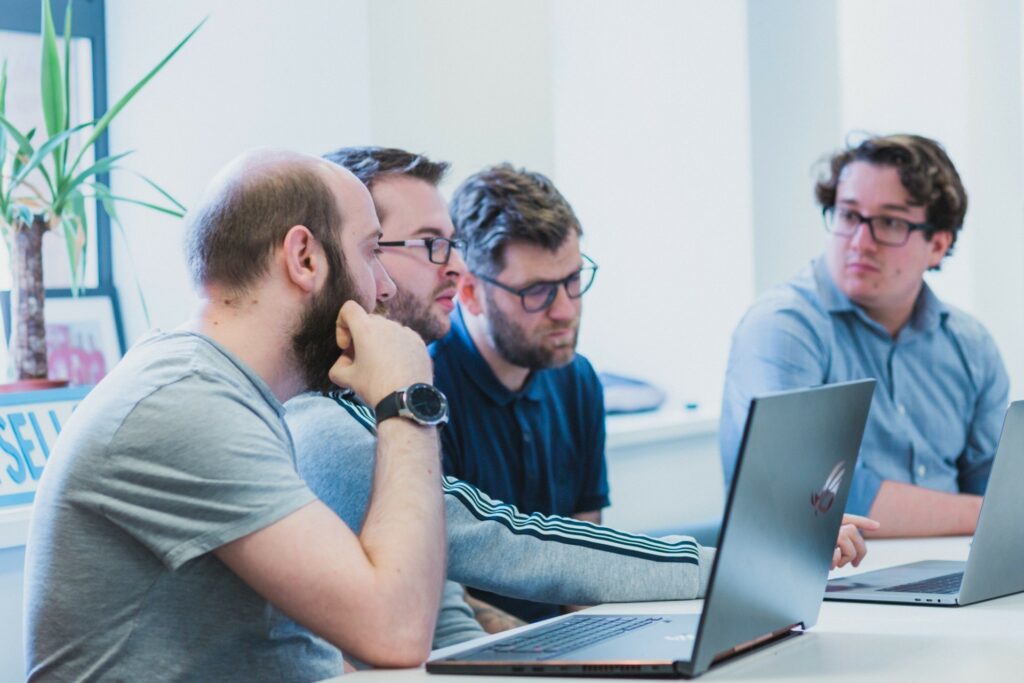What is Discovery?
Discovery is the name given to the second stage of our projects. Once a client has finalised our consultants’ proposal‚ the project then passes to the Discovery team. It’s here that the client’s platform really starts coming to life.
Our aim in Discovery is to help our clients and developers better visualise the finished platform. Discovery provides exact technical specifications and visual designs that cover all of our client’s needs and flag up potential issues.
Meet the Team
9am
We all gather for our daily ‘stand-up’. These are quick‚ informal meetings where we discuss what we managed to get done the previous day and what’s on the agenda for today. These stand-ups keep us all up to date with each other.
9:15am
Andrew: After the stand-up‚ I begin work on some estimates for a new project that has just entered Discovery. In order to estimate each project‚ I set out all tasks (we use JIRA for this) and allocate time for each. Scheduling the team is part of my role as Head of Discovery.
Charlie: Yesterday I ended work with half-complete admin wireframes so I start back on them immediately after stand-up. Each platform we create has a customer-facing side and an administrative side. Admin wireframes mock-up what the latter side will look like. Wireframes ensure that all the functionality the client needs is accounted for and accessible.
Scott: The high-fidelity prototypes I sent over to a client have come back with suggested edits. The Discovery process is a back and forth with the client and we make sure that the client is as engaged as possible. Getting feedback now really helps ensure that the development stage goes smoothly. I spend most of the morning seeing to the changes they want.
Dan: As the User Experience Designer‚ I spend a lot of my time making user-facing wireframes. Today is no different – I’m working on some wireframes for a big project. Wireframes are always a really important part of Discovery but they’re especially important for bigger projects as they allow the client to visualise the end product. As so much time will go into the development of this product‚ it’s essential the wireframes fit what the client had in mind.
11am
Andrew: A client whose product is about to go through Discovery comes in for a meeting. Meetings are a huge part of the job for Charlie and I and the session is really useful. We discuss what their main business goals are and what they want the platform to achieve. After the meeting‚ I conduct some analysis of their competitors in order to place their goals in the wider context of their industry.
Charlie: Andrew and I spend a productive hour in a client meeting. I come out of the meeting feeling clear about the direction of the project and start working on some process maps for the client after lunch. These process maps draw out the user journey in order to establish the main priorities for the product.
1pm
Scott: After lunch I switch from working on the edits to designing branding for another client. As a recent startup‚ the client needed our help with the branding aspect of the prototype so I’m designing some examples based off our conversations. After I’ve completed these I’ll send them over and see how they’re feeling about them.
2pm
Dan: After a post-lunch internal meeting‚ I start on some wireframes for the internal product we were discussing. There’s already a version of this platform but it’s going back through Discovery so we can visualise how the new features would fit with the pre-existing platform.
4pm
We have an internal meeting with our consultants about a new project on the pipeline. We’re all really excited about this platform as it will involve AR. We recently completed work on our first AR project so we’re eager to get to grips with some more. The meeting goes well and it feels like a good way to end a productive day for the team.






